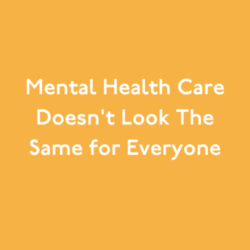It’s 8:10 a.m. at Indian Head Elementary School in Charles County, Maryland. The classroom is quiet. The lights are low. Students pause for their morning check-in.
“Let’s take a deep breath together. What’s one word for how you’re feeling today?”
Hands rise: “excited,” “tired,” “nervous.” A few students just nod. Their teacher smiles and says, “Thank you for sharing.”
It’s hardly a spectacle, but over time, that daily reset has reshaped the tenor of the day. Teachers say students arrive more grounded. Less tension. Fewer outbursts. More openness. One educator shared, “We see students articulate what they feel. They ask for rest when needed. And it helps everyone, staff and learners, show up more ready to do the work.”
This is preventive mental health in action: small, consistent practices woven into the school day that change culture and quiet stress before it escalates.
Every year on World Mental Health Day, we’re reminded that emotional wellbeing isn’t just something to talk about once a year, it’s something to nurture every day.
At Move This World, we’re thinking about all of the people who make up our communities — students, educators, families, and caregivers — who show up every day doing their best to care, to learn, to listen, and to keep going.
We often focus on achievement, performance, and outcomes. But real success begins beneath the surface with emotional wellbeing. When people feel safe, seen, and supported, they can connect, create, and thrive.
This small moment at Indian Elementary captures a powerful truth: emotional wellbeing isn’t separate from learning, it’s what makes learning possible.
.Why Prevention Matters
Across Move This World partner schools, daily routines like these have become anchors, small acts of care that make a big difference. They’re reminders that mental health isn’t only about intervention when something goes wrong; it’s about nurturing the skills and habits that help us stay grounded, connected, and resilient in the first place.
A proactive approach to mental health means helping students and educators alike build awareness and connection before stress becomes struggle. It means treating emotional wellbeing not as an “extra,” but as a daily practice that strengthens everything else, attention, relationships, and academic growth.
These moments don’t take time away from learning. They create the conditions for it. These few minutes of grounding don’t take away from academic time, they give it meaning. At Indian Head Elementary, those morning check-ins are more than a routine. They’re a symbol of what’s possible when a school commits to proactive care. Teachers have noticed fewer disruptions, more empathy between students, and a calmer start to each day.
In every setting across rural, urban, suburban, or virtual districts, the message is the same: when we invest in wellbeing, we create space for deeper learning and stronger connection.
Wellbeing Drives Better Learning. But don’t just take my word for it; look at the research:
1. Emotional Awareness Strengthens Focus and Achievement
Studies show that when students regularly practice naming and understanding their emotions, they demonstrate better focus, higher motivation, and stronger academic outcomes (CDC, 2023).
Meta-analyses covering tens of thousands of students confirm that proactive emotional skill-building leads to higher test scores, improved attendance, and fewer disciplinary incidents (ScienceDirect, 2024).
2. Supportive Environments Improve School Climate
Schools that intentionally nurture emotional wellbeing experience greater academic gains, improved relationships, and reduced stress among both students and staff (CARS Research Brief, 2023).
The National Center for School Mental Health also notes that schools integrating daily emotional practices see increased teacher retention, improved morale, and stronger sense of community (SchoolMentalHealth.org, 2023).
3. Early Emotional Support Builds Lifelong Resilience
Long-term research shows that nurturing emotional skills early in life leads to better academic, professional, and health outcomes well into adulthood (Seattle Social Development Project).
These findings echo what schools like Indian Head Elementary have seen firsthand. Emotional wellbeing isn’t just protective, it’s productive for learning. It creates the foundation where students can grow, learn, and lead.
TLDR; prevention pays off. When students and teachers know how to care for their emotional health, the entire community benefits, from academic outcomes to school climate to lifelong resilience.
Everyday Practices That Build Strong Foundations
Promoting mental health in schools doesn’t require extra hours in the day; it starts with intentionality. Simple, consistent habits can create ripple effects that last all year:
- Start the day with a check-in. Ask: “What’s one word for how you’re feeling?” Begin the day with a short check-in or breathing exercise to set a calm tone.
- Normalize emotional honesty. Model calm and curiosity, not perfection. When adults acknowledge their feelings, students learn that emotions are natural, not distractions.
- Build shared rituals. A moment of quiet, gratitude, or reflection can reset energy for learning.
- Care for the caregivers. Adults who take time to regulate and reflect model those same skills for students. When educators tend to their own wellbeing, they model balance and compassion for students.
These everyday moments help build the trust and safety that make authentic learning possible. These choices create classrooms where emotions are not distractions, they’re doorways to understanding and growth. Schools and homes are not just places where we “get things done.” They are the spaces where belonging is built. A kind word, a pause before reacting, or a shared moment of understanding, these small acts strengthen the foundation of community.
Connection protects us. It reminds us that we’re part of something larger, that we’re not alone, and that support is always possible.
Our Commitment
At Move This World, we partner with schools and districts like Indian Head Elementary in Charles County, Maryland to embed these daily practices of connection and care into the fabric of learning. Through creative tools and guided routines, we help students and educators strengthen the emotional foundations that support growth, belonging, and success, in school and beyond.
Every year, on World Mental Health Day, we’re reminded that emotional wellbeing isn’t an extra, it’s essential.
When students, educators, and families feel safe, seen, and supported, the conditions for growth, creativity, and connection take root. This is the foundation of thriving communities, and it’s why proactive care for our emotional health belongs at the center of education.
#WorldMentalHealthDay #EmotionalWellbeing #CommunityCare #Education #MoveThisWorld









